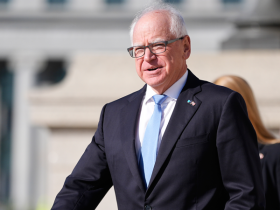The NFL will continue its social justice messaging for the sixth consecutive season.
Teams can choose from four end zone messages: ‘End Racism,’ ‘Stop Hate,’ ‘Choose Love,’ and the new ‘Inspire Change.’
The NFL’s social justice messaging is here to stay.
For the sixth straight season, all 32 teams will display one of four social justice messages in the end zone at each home game. Teams can pick from ‘End Racism,’ ‘Stop Hate,’ ‘Choose Love’ or ‘Inspire Change,’ which is a new addition that replaces the ‘Vote’ stencil from 2024.
Those messages will appear at one end zone, while ‘It Takes All of Us’ continues to be stenciled at the other.
‘We’re working hand-in-hand with players, and alongside our clubs, to amplify player voices and underscore what is most important to them,’ Anna Isaacson, the NFL’s senior vice president of social responsibility, told The Associated Press. ‘For decades, the NFL and its players have been a unifying force in American culture and society that brings people of all cultures and backgrounds together to enjoy America’s most popular sport.
‘This is an honor and responsibility that the league takes seriously, which is why we actively invest in off-field programs and on-field initiatives that promote unity.’
All international games will feature ‘End Racism’ and ‘It Takes All of Us’ in the end zones.
The Philadelphia Eagles have selected ‘Choose Love’ as their season-opener message on Sept. 4 against the Dallas Cowboys and will rotate all four messages throughout the season.
Once again, players can choose to feature one of the five messages on their helmets.
According to the AP, the NFL has provided more than $460 million to dozens of grant partners and hundreds of grassroots organizations through its Inspire Change initiative, benefiting communities in need since 2017. The Inspire Change initiative has supported over 650 nonprofits and 2,100 players and alums, providing matching grants focused on mentorship, workforce development and addressing food insecurity.










